

 |
 |
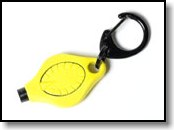 I carry a number of flashlights for personal use or in my survival kits. The ones I carry on my person are there as much for daily convenience as for potential survival use and are part of my "don't leave home without it" gear. Flashlights are one of those tools that are extremely handy for everyday use and which can also be life savers in an emergency. It's nice to make an investment in safety and survival that you actually get benefit from in normal life. This also makes it easier to invest in higher quality, because in many cases you'll be using it every day.
I carry a number of flashlights for personal use or in my survival kits. The ones I carry on my person are there as much for daily convenience as for potential survival use and are part of my "don't leave home without it" gear. Flashlights are one of those tools that are extremely handy for everyday use and which can also be life savers in an emergency. It's nice to make an investment in safety and survival that you actually get benefit from in normal life. This also makes it easier to invest in higher quality, because in many cases you'll be using it every day.
The fact of the matter is that humans don't have particularly good night vision and when it's dark we are significantly disabled. It doesn't even have to be nighttime for a flashlight to come in very handy. Especially in the urban environment, there are lots of opportunities for the lights to fail during the day in situations where there is no external source of lights. While most such places in the first world are equipped with emergency lighting, not the case in the second and third world, it is generally not very effective, at best, and often fails to work or is virtually ineffective in some circumstances.
If you want to be able to operate at night or in darkness, the only sure source of light is the light you bring with you. With the advent of compact and affordable LED keychain-size flashlights, there's no reason for anyone not to carry a flashlight at all times. At least one good flashlight ought be part of any survival kit bigger than pocket sized (and that assumes you're already carrying a keychain-sized flashlight in your pocket). Ideally, it should be compact, lightweight, have a reasonably bright, evenly distributed beam that isn't too narrow and it should last for quite a while on a set of batteries.
Use only alkaline or lithium batteries for flashlights, or any other battery operated devices that you anticipate using for survival. All good brand name batteries are now marked with an expiration date, but if the batteries you buy are not dated, always mark them with an expiration date. A conservative storage life for undated no-name alkaline batteries would be 3-4 years. Never use old-fashioned zinc-carbon batteries. Batteries marketed as "heavy duty" are just deceptively named zinc-carbon batteries. If it doesn't say "alkaline" or "lithium" on the battery, it isn't. If at all possible, try also not to rely for survival use on devices that must use proprietary rechargeable batteries. They simply do not hold a charge for very long, so unless they are regularly and religiously recharged they will be dead when you need them the most.
With the improved shelf life and run time of even standard alkaline batteries compared to those made just a few years ago and the reliability and long battery life of most small LED flashlights, there's a tendency to forget that the battery(ies) will eventually give out. Since many LED flashlights will run at a diminished light output for hours even after the batteries have run down, this makes it even easier to fall into this sort of trap. This is an even bigger issue if you still use an incandescent flashlight. Batteries are relatively cheap and when you really need it, a working flashlight is priceless. I change out my batteries on a regular rotation and I also change them out if I've had reason to use the flashlight for a long time in any particular instance.
In any case, no matter the batteries used, be sure to note the expiration date somewhere that it will be noticed and do some good before they expire. These days most computers come with a software package that includes some sort of calender/reminder program, or there are numerous free reminder software packages or web sites on the Web. I find this the easiest way to keep track of expiration dates. (Also a very good way to remind you to change out the batteries in your home smoke detectors annually)
Any brand name alkaline battery will probably do fine. Consumer Reports tested both name brand and store brand batteries and found no clear winner as far as power duration was concerned, despite the Bunny's efforts to convince us otherwise. For what it's worth, I think that the construction quality of the top name brand batteries is better and they are less likely to leak or have problems from long term storage. I use only dated Duracell and Energizer brand batteries.
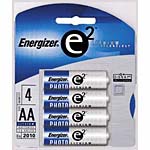 While quite a bit more expensive than alkaline batteries, lithium batteries are well worth it in my opinion. These are the best choice for survival kit use because of their long shelf life, up to 10 years, with 90% to 95% capacity, or better, retained. This goes a long ways towards countering the old joke about flashlights just being containers for dead batteries.
While quite a bit more expensive than alkaline batteries, lithium batteries are well worth it in my opinion. These are the best choice for survival kit use because of their long shelf life, up to 10 years, with 90% to 95% capacity, or better, retained. This goes a long ways towards countering the old joke about flashlights just being containers for dead batteries.
Lithium batteries also deliver far better cold weather performance than alkaline batteries. In most battery-powered devices, especially flashlights, they also last longer in use. An added benefit is that they are lighter than alkaline batteries by over one third (14.5g vs. 23g for the AA-cell). That can add up if you are using a number of battery powered devices. I pack only lithium batteries in my survival kits. AA-cell, AAA-cell and 9-volt size lithium batteries are available from Eveready Battery Co. under the "Energizer" brand name.
If your flashlights or other devices are powered by 123-cell lithium batteries, as many high performance flashlights are, the very best deal on first quality batteries is direct from Surefire who have their Surefire brand batteries made by a brand name manufacturer and then sell them at low cost. They initially did this to help counter these batteries' traditional high cost, which was proving to be a detriment to sales of their lights, most of which are powered by these batteries. Their sales inducement now benefits all of us who use these size batteries.
Virtually all the smallest single LED keychain lights use lithium "coin" cell batteries, which these days are readily available in most drug and hardware stores in the U.S. and Canada. However, if you're traveling outside North America, especially to second or third world countries, make sure you take spare lithium batteries. They are generally much more difficult, if not impossible, to find there.
It's good practice to always carry a spare set of batteries in your survival kit or auto glove box, or more than one set if warranted. Some experts prefer not to keep any batteries in the battery-powered device(s) when in storage, for fear that they could leak and damage the light. If replaced regularly, before they get too old, this is rarely a problem. The vast majority of leaking batteries are years out of date, according to the manufacturers. In any case, I'd suggest that at least one light source be ready for immediate use, easy to find (I clip one to the outside of my aviation survival kit) so that there is light available to unpack the kit and to install the batteries in the other devices, if the batteries are stored separately.
Make sure that you store spare batteries in a manner that they cannot short circuit. You can purchase specialized battery storage containers for popular size batteries, simply use the orgignal packaging, secure the batteries with a rubber band and place inside a plastic bag, or wrap with plastic wrap.
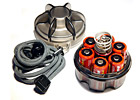 In addition, if you are including an incandescent flashlight, always carry at least one spare bulb. These are the most easily damaged and least reliable part of any flashlight and, at best, have an indeterminate working life. Some flashlights come with or have space to store a spare bulb in the tail cap or head. However, always check the spare bulb(s) to be sure you aren't packing a dud. The bulbs for most of the high tech flashlights are pretty fragile and you should never touch the bulb itself with bare fingers. Ensure they won't be crushed while packed. A small pill vial, 35mm film canister or similar container and some cotton packing is one reliable method to safeguard them. Surefire makes a nifty carrier for its flashlights that holds one bulb and four or six replacement batteries, all in a crush proof package.
In addition, if you are including an incandescent flashlight, always carry at least one spare bulb. These are the most easily damaged and least reliable part of any flashlight and, at best, have an indeterminate working life. Some flashlights come with or have space to store a spare bulb in the tail cap or head. However, always check the spare bulb(s) to be sure you aren't packing a dud. The bulbs for most of the high tech flashlights are pretty fragile and you should never touch the bulb itself with bare fingers. Ensure they won't be crushed while packed. A small pill vial, 35mm film canister or similar container and some cotton packing is one reliable method to safeguard them. Surefire makes a nifty carrier for its flashlights that holds one bulb and four or six replacement batteries, all in a crush proof package.
Make sure that there is no way the flashlight stored in your kit or glovebox, etc., can be turned on inadvertently, if batteries are installed. Even some seemingly foolproof switch designs seem to find ways to turn themselves on. Some flashlights do have lock-out switches that prevent inadvertent activation, but they are rare. One method we have found to work for flashlights with press-on-press-off button switches on the body, is to take thin plastic tubing (try a hardware or plumbing store) large enough to almost, but not quite, slip around the body, then cut it long enough to cover the switch, then split it vertically so it can be spread slightly. It will grip securely and prevent inadvertent activation, but can be easily removed.
Small single LED keychain flashlights can be a more difficult problem. Generally, you use them to save space and bulky packaging to protect the switch defeats that purpose. For storage puposes you need a light that either only has a slide switch, and those are few and far between and the ones I've seen have not be very good quality, or some means to either disable or defeat any pressure switch. The lead to the pressure switch on an Emissive Energy Corp. Inova Microlight
can be carefully broken/cut off to leave it slide-switch-only operable (this will void the warranty). LRI Photon Micro-Lights can be installed upside down in the Quick Release molded Photon Carrier (as shown in this example using the Doug Ritter Special Edition Photon Freedom Micro) or the Freedom series can be left in Demonstration mode to prevent them from depleting the battery if the switch is pressed.Many lights that switch by rotating the head in to switch on can be secured by a piece of hard cardboard or incompressible rubber sheet thick enough to prevent the head from being turned down far enough to activate the light, generally 1/8 in or so. Cut it slightly larger than the outside diameter of the head, big enough to be easily grasped, perhaps with a tab to make it even easier. Then cut a hole in the center the outside diameter of the threaded portion of the body. (Note: for some lights, a standard hard rubber hose washer fits perfectly, with less fuss. You might also check out the store's gasket or rubber washer selection as well for one the right size.) Slit it, opposite the tab if you've included one, and then place it between the head and the body, tightening the head down on it. To use the light, just rotate the head out slightly and pull the spacer out.
For lights like the Mini-Maglite and its clones, the only solution I've found is to affix a piece of electrical or duct tape over the junction of the body and the head. This will be much easier to remove if you leave something to grasp. Folding a piece of the end of the tape back on itself so it doesn't stick will do the trick, but make sure to leave plenty to grasp. The tape trick will also work for those flashlights with slide switches.
For pilots, boaters and others who wish to retain whatever night vision you have, a red light has been the traditional choice since before WWII when the military settled on red as the best choice. Recently, there has been a move to green and blue-green light. Which is really better? Well it's not quite cut-and-dried, as our brief explanation, "Green or Red for Better Night Vision?" explains.
Most of us have had the annoying experience of the bulb failing in our flashlight, often after a drop to the floor, but in any case almost always at a less than opportune moment. Even when there's a spare handy, changing it can be a challenge in the dark.� How appealing would you find a flashlight with a bulb that never burns out, or at least not for tens of thousands of hours?
Then there's battery life, or lack thereof.� If the bulb isn't failing, the batteries are petering out.� The light dims and is extinguished just about the time you need it the most.� Even if you have spares, changing them in the dark is usually a trial.� How appealing would you find a flashlight whose batteries last tens of hours, or even more?
We're talking about flashlights that use LEDs (Light Emitting Diodes) instead of conventional incandescent bulbs. Yes, these are the same technology we've seen in electronic equipment, digital signs, cheap key ring lights, and the like for years.� The problem has been that while LEDs came in an array of colors, they didn't come in white--until relatively recently.�Other colors might suffice to light up a keyhole or to read a chart without diminishing your night vision, but for general practical use they left a good deal to be desired.
White LED flashlights are now readily available and they are getting better and evolving fast. They range from the diminutive single LED Photon Micro-Lights that pioneered this product for consumer use, and the many clones, to larger lights with arrays of tens of LEDs or higher performance 1-watt, 3 watt and 5-watt LEDs that compare in performance to some high-performance incandescent bulbs. These LEDS are virtually bomb-proof, withstanding substantial abuse and shock without failing and are generally more efficient than incandescent bulbs, runnibg longer on a set of batteries.
With the exception of tactical or self-defense use, or under limited special circumstances, incandescent handheld flashlights have been eclipsed by LED flashlights. And, even for these special uses, higher powered LED flashlights are starting to come into their own. LEDs represent a revolutionary technology that is relegating older technology to the wastebin as far as quality flashlights are concerned. For most common everyday and survival uses, the only advantage an incandescent flashlight has is potentially lower initial cost. I carry only LED flashlights for everyday use.
Click here to read Equipped To Survive's™ extensive review of LED flashlights.
I chose a Tekna "Splash-Lite" to attach to the outside of my kit where I can easily find it. It is very small, waterproof, uses a lithium battery (3 volt "L" cell), and cannot be turned on accidentally. A second Splash-Lite is inside the Comprehensive Medical Kit. The Splash-Lite is very hard to find these days, but similar lights are available from other sources such as the Tektite "Micralite Lithium." which uses a single AA-cell lithium battery or the 2-AAA alkaline battery powered UKE Mini-Pocket Light or single AA-Cell Pelican MiniMityLite, all of which have brighter beams. A better choice these days would be a small white-LED flashlight.
Two series of flashlights I have found to be excellent are made by Underwater Kinetics (these were also marketed for a time under the "BuckLight" brand name by Buck Knives) and Pelican Products (also marketed under the Browning brand name). Both have their roots in scuba diving products, so their products are all seriously waterproof.
The "UKE 2L" is a lithium powered model that is compact, very bright with excellent beam quality and reasonably long lived. It will last about 3.5 hours in constant use, much longer if used intermittently, as is normally the case. It uses two of the small 3 volt lithium "L" cells. I include one of these in my kits. The "UKE 4AA" uses the same excellent bulb module as the 2L, but runs on four AA-cell batteries in a 2+2 stacked design. Run time is comparable to the 2L.
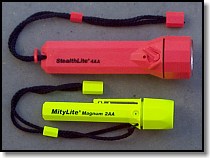 The Pelican "MityLite Magnum 2AA" offers comparable performance, though the beam quality is not as smooth and has a bit less spread, but it is still very bright and very robust. It also only requires 2 batteries and is lighter and somewhat more compact. The Pelican StealthLite 4AA has a larger head than the compareable UKE, but it also puts out a far brighter and more focused light beam.
The Pelican "MityLite Magnum 2AA" offers comparable performance, though the beam quality is not as smooth and has a bit less spread, but it is still very bright and very robust. It also only requires 2 batteries and is lighter and somewhat more compact. The Pelican StealthLite 4AA has a larger head than the compareable UKE, but it also puts out a far brighter and more focused light beam.
The beam on these lights is better, in most respects, than
conventional or Maglite style
C- and D-cell lights. They have the advantage of being more
compact and lighter than
standard C- and D-cell flashlights and are much more comfortable
to hold due to the smaller
size. Spare batteries of either size take up much less room and
weight (especially if you use lithium batteries) than larger batteries
for flashlights which generally don't even approach their
performance.
 For a penlight size flashlight, the two AAA-cell
powered Underwater Kinetics Lights (Pen Light and Mini-Pocket Light) are top rated along with with the Pelican MiniMityLite, Mitylite and Super Mitylite. The difference, again, being the beam, with the pelican offering a more focused beam.
The biggest drawback to these small pen lights is the very small beam width. I prefer a bit wider beam for general survival use even if giving up some apparent brightness, though the narrower, brighter beam of the Pelican lights would be an asset for signaling use. If looking to minimize weight, however, these would be a good choice. Beam quality of these lights far surpass comparable MiniMaglite flashlights or
clones in my opinion, as well as conventional lights. Both the single cell MiniMityLight and the UKE Mini-Pocket Light with it's stacked cell design are compact enough to keep on a key ring or in your pants
pocket, handy at all times. I always carry one.
For a penlight size flashlight, the two AAA-cell
powered Underwater Kinetics Lights (Pen Light and Mini-Pocket Light) are top rated along with with the Pelican MiniMityLite, Mitylite and Super Mitylite. The difference, again, being the beam, with the pelican offering a more focused beam.
The biggest drawback to these small pen lights is the very small beam width. I prefer a bit wider beam for general survival use even if giving up some apparent brightness, though the narrower, brighter beam of the Pelican lights would be an asset for signaling use. If looking to minimize weight, however, these would be a good choice. Beam quality of these lights far surpass comparable MiniMaglite flashlights or
clones in my opinion, as well as conventional lights. Both the single cell MiniMityLight and the UKE Mini-Pocket Light with it's stacked cell design are compact enough to keep on a key ring or in your pants
pocket, handy at all times. I always carry one.
Another top rated series of flashlights are the Rayovac Industrials with a Krypton bulb. Both the 2AA and 2D size versions have good beam quality and long life at low cost, though they are bulkier than the UKE or Pelican lights and not totally waterproof.
If the objective is the maximum light for the minimum size, what we refer to as a "pocket searchlight," absolutely nothing beats the Laser Products "Sure-Fire" series of lithium and ni-cad powered flashlights. While they are easily among the most expensive flashlights on the market, they represent a good value, if quality and high light output is important. Precision machined aluminum bodies and precision focused high intensity xenon bulb modules give unparalleled performance. Compared to the ubiquitous 3-D cell MagLite, the 6 and 9 series lights give 2 to 4 times the light output and offer far superior beam quality in a package that is a one sixth the size. The only downside is that all that light comes at the expense of run time, generally only about 50 minutes to 1.25 hours continuous use. Still, those lithium L cells are small and light, so carrying spares is no problem.
The 6P (4.85 inches) and 9P (6.2 inches) models use 2 and 3 L-cells, respectively. The 6R (6.85 inches) has a rechargeable ni-cad battery, but is easily converted to a pair of lithium cells, a nice feature for a working light that might also be needed in an emergency. The 7Z CombatLight is similar in size to the 6R, but is has specific features incorporated designed to make it work even better as a handheld light when used in conjunction with a handgun.
Sure-Fire offers a whole range of options for the flash lights (as well as some other, even brighter lights): beam shapers, beam filters, and "turbo-heads" for even more light, to name but a few.
There are times when you wish you had both hands free to work and light on the subject as well. There are three general purpose solutions. First is the old "hold it in the mouth" trick. This gets tiring after a while and is far from the best solution. it simply won't work with a larger flashlight. Second is a head strap which holds a small flashlight on the side of your head with an elastic strap. Third is a special purposed flashlight, the headlamp.
The head strap is the most practical solution since it allows you to use the same flashlight as you normally carry. The best strap I have found, and include in my own kit, is the "Jakstrap System II" by Liston Concepts. It has a wide elastic band which is adjustable via a Velcro closure. The flashlight holder is also adjustable so it will accommodate any of the small flashlights up to 4-AA stacked size, including those recommended here, with ease. It will hold many 2-C size flashlights as well, though that gets more than a little bit unwieldy.
The best headlamps I've found are by Petzl. They come in a variety of styles, but for basic use the "Micro" with a halogen bulb works fine. For cold weather use they make an "Arctic" model which puts the battery in a neck pouch to keep it warm.
A compromise that is neither fish nor fowl is the Pelican "VersaBrite" and "VersaBrite II Big Beam" The VersaBrite has a unique swivel head (up and down only) attached to a body with 2 side by side AA cells, which makes it easy to stand up and shine where needed. A wide integral clip which worked on hat visors or pockets, side clips, optional Velcro attachment and elastic headband make it a versatile performer, despite the somewhat lesser beam quality, the same as the MityLite and Magnum, respectively. Not perfect at any one thing, but very adaptable. The VersaBrite II, with it's larger head and better reflector, is the best choice of the two and could easily function as a kit's sole flashlight.
NOTE: An alternative to chemical lightsticks that addresses many of their shortcomings is the electroluminescent Krill Lamp. Powered by a pair of AA-cell batteries, they last up to 120 hours and can be switched on and off as needed. Check out our detailed evaluation of the Krill Lamps.
A note of caution; these lightsticks are packaged in airtight
pressurized foil packaging
and if punctured will quickly become useless, especially in humid climates. Shelf
life varies with the standard
lightsticks lasting about 4 years from date of manufacture down
to one year for the ultra high
intensity versions.
If the lightstick itself leaks from being crushed or punctured, the non-toxic chemical
creates a gross and indelible stain (been there, done that mode). While not lethal, the chemicals involved can be a skin irritant to some, and in some cases a severe irritant. The tiny glass shards that are mixed in with the liquid once the light has been activated could also cause problems. You definitely want to avoid getting the chemicals or class shards in any open wound. When packing these, best to provide them with protection from crushing and puncture. Larger cigar tubes work great. Some travel containers for toothbrushes and Tampax will also provide protection.
Publisher and Editor: Doug Ritter
 "Cyalume," or
"Snap Light" (both manufactured by Omniglow Corp.) chemiluminescent lightsticks
provide reliable general low level illumination for longer
periods, 8 to 12 hours. These can
be especially valuable for those unaccustomed to spending the
night in the wilderness as a "night-light".
"Cyalume," or
"Snap Light" (both manufactured by Omniglow Corp.) chemiluminescent lightsticks
provide reliable general low level illumination for longer
periods, 8 to 12 hours. These can
be especially valuable for those unaccustomed to spending the
night in the wilderness as a "night-light". 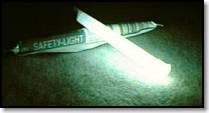 No matter how useful they are, they do have their shortcomings. Once activated by breaking the internal glass vial and combining the chemicals, they cannot be turned off. That can be inconvenient, as well as annoying. They provide increasingly less illumination as temperatures drop, even at temps well above freezing, and less duration as temperatures increase above 80 degrees F. The high intensity chem-lights were originally developed to combat the cold weather problem. While they last only a short time at normal temperatures (5 and 30 minutes), they last longer, if not a long time, at low temperatures and give more illumination. Whether you need 360-degree illumination or not, that's what you get. The 8- and 12-hour chem-lights will start to dim after a few hours and dim considerably towards the end of their rated life.
No matter how useful they are, they do have their shortcomings. Once activated by breaking the internal glass vial and combining the chemicals, they cannot be turned off. That can be inconvenient, as well as annoying. They provide increasingly less illumination as temperatures drop, even at temps well above freezing, and less duration as temperatures increase above 80 degrees F. The high intensity chem-lights were originally developed to combat the cold weather problem. While they last only a short time at normal temperatures (5 and 30 minutes), they last longer, if not a long time, at low temperatures and give more illumination. Whether you need 360-degree illumination or not, that's what you get. The 8- and 12-hour chem-lights will start to dim after a few hours and dim considerably towards the end of their rated life.
« Prev. ![]()
![]() Next »
Next »
![]()
SELECT AND USE OUTDOORS AND SURVIVAL EQUIPMENT, SUPPLIES AND TECHNIQUES AT YOUR OWN RISK. Please review the full WARNING & DISCLAIMER about information on this site.
Email: Doug Ritter
URL:
http://www.equipped.org/devices27.htm
Revision: 013 May 21, 2003
![]()
Email to: [email protected]
© 1994 - 2003 Douglas S. Ritter & Equipped To Survive Foundation, Inc.
All rights reserved.
Check our Copyright Information page for additional information.
Read the ETS
Privacy Policy